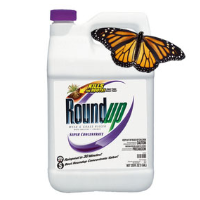After 8 Years of Delay, EPA Finally Agrees to Test Dangers of Monsanto’s Favorite Pesticide
 (photo illustration: Steve Straehley, AllGov)
(photo illustration: Steve Straehley, AllGov)
Glyphosate, which is the active ingredient in Monsanto’s Roundup herbicide, will finally undergo analysis for its effects on endangered species by the Environmental Protection Agency (EPA), thanks to the persistence of the Center for Biological Diversity (CBD).
The group has been trying for eight years to get the EPA to look at glyphosate, along with atrazine and two chemicals similar to atrazine: propazine and simazine. Glyphosate was found two months ago by the World Health Organization’s International Agency for Research on Cancer to be a probable human carcinogen and was banned for sale in garden centers in France earlier this month.
“This settlement will finally force the EPA to consider the impacts of glyphosate—widely known as Roundup—which is the most commonly used pesticide in the United States, on endangered species nationwide,” said Brett Hartl, CBD’s endangered species policy director. “With more than 300 million pounds of this stuff being dumped on our landscape each year, it’s hard to even fathom the damage it’s doing.”
Roundup appears to be responsible for the 90% drop in the number of monarch butterflies in the United States. The butterflies feed on milkweed, which has been just about eliminated because of Roundup use in fields near butterflies’ habitats.
Monsanto spokesman Robb Fraley said Roundup meets standards set by regulatory and health authorities. However, the EPA hasn’t ever taken a close look at glyphosate’s effect on endangered species.
Atrazine chemically castrates frogs and may be linked to increased risks of thyroid cancer, reproductive harm and birth defects in humans, according to CBD. “The EPA should have banned this years ago,” Hartl said. Up to 80 million pounds of atrazine are used each year in the United States on corn, sugarcane and sorghum, as well as lawns and golf courses.
The EPA’s agreement is only the beginning of a long, slow process. The agency has agreed to complete its assessments by 2020.
-Steve Straehley
To Learn More:
Big Win for Environmentalists Will Force EPA to Study Glyphosate (by Elizabeth Warmerdam, Courthouse News Service)
Settlement: EPA to Analyze Impacts of World’s Two Most Widely Used Pesticides on 1,500 Endangered Species (Center for Biological Diversity)
UN Report Links California’s Favorite Herbicide, Monsanto’s Roundup, to Cancer (by Ken Broder, AllGov California)
EPA Sued over Not Protecting Decimated Monarch Butterflies from Monsanto (by Noel Brinkerhoff and Ken Broder, AllGov California)
EPA Approves Rise in Glyphosate Residue for Monsanto’s Herbicide (by Noel Brinkerhoff, AllGov)
- Top Stories
- Unusual News
- Where is the Money Going?
- Controversies
- U.S. and the World
- Appointments and Resignations
- Latest News
- Trump to Stop Deportations If…
- Trump Denounces World Series
- What If China Invaded the United States?
- Donald Trump Has a Mental Health Problem and It Has a Name
- Trump Goes on Renaming Frenzy






Comments